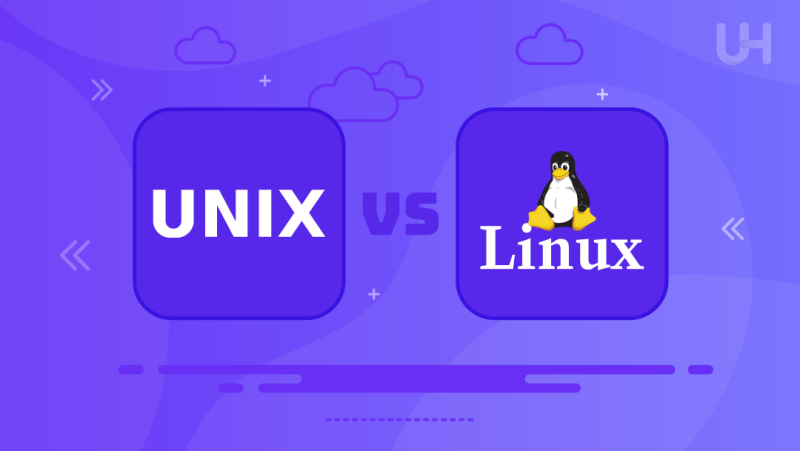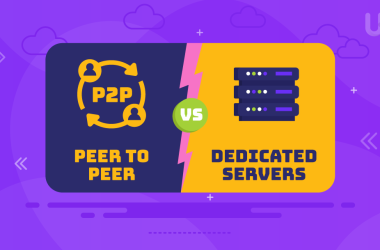Imagine your computer’s operating system as the brain that makes everything work seamlessly. In the tech world, two heavyweights—Unix and Linux—have been around for a while, influencing how our devices function. You might have heard the debate about Unix vs Linux tossed around, but what’s the real deal behind them?
Well, Unix is like the OG, born in the 1960s, shaping the basics of how computers operate. Then comes Linux, the younger sibling from the ’90s, taking what Unix started and adding its own flair, becoming a big deal in the world of free and open-source software. Let’s see what makes Linux and Unix different and how they’ve played a role in the technology we use every day.
Unix vs Linux: Overview
At its core, Unix follows a modular design, dividing functionalities into small, specialized programs that work together seamlessly. The hallmark of Unix lies in its multi-user and multitasking capabilities, allowing several users to run multiple processes concurrently. The file system structure is hierarchical, with directories and files organized in a tree-like format. Unix also emphasizes a philosophy of “everything is a file,” treating devices, directories, and even hardware as files to provide a unified and consistent interface.
Often referred to as a Unix-like operating system, Linux adopted key principles from Unix while adding its own innovations. One significant aspect is the open-source nature of Linux, allowing users to access and modify the source code, fostering a collaborative and community-driven development model. Linux inherits Unix’s core features, including multitasking, multi-user support, and a similar file system structure. This Unix-like nature enables users familiar with Unix systems to navigate Linux environments with ease, creating a sense of familiarity and continuity.
Kernel Difference Between Linux and Unix
At the heart of both Unix and Linux is the kernel, the essential component that interacts with hardware and facilitates communication between software and hardware components. While Unix has various versions with distinct kernels (such as AIX, HP-UX, and Solaris), Linux distributions (distros) also feature different kernels. The Linux kernel, originally developed by Linus Torvalds, is a key differentiator, offering flexibility for users to choose the kernel that best suits their needs, be it for an Ubuntu VPS server, CentOS, or another distribution. Despite these variations, both Unix and Linux kernels share common traits, including the ability to manage processes, memory, and hardware resources efficiently.
Licensing and Distribution
Unix follows a licensing and distribution model characterized by vendor ownership and restricted access to source code. The proprietary nature of Unix means that individual vendors develop and distribute their versions, often tailored to specific hardware platforms. This exclusivity has historical implications for accessibility, as users may face higher costs, limited access to source code, and a reliance on vendor-specific support.
In contrast, Linux has become synonymous with openness, adopting an open-source model that allows users to view, modify, and distribute the source code freely. This approach has democratized access to a robust operating system, making Linux a popular choice for individuals, businesses, and educational institutions. The open-source philosophy has given rise to a diverse array of Linux distributions for hosting, each catering to different needs and preferences, and has cultivated a collaborative community that actively contributes to the system’s development.
Command Line Interface Unix vs Linux Difference
The Command Line Interface (CLI) serves as the digital backbone of both Unix and Linux, providing users with a powerful and efficient means of interacting with the operating system. While both systems share a similar textual interface, there are differences in their command structures. Unix commands often vary between different versions (like AIX, HP-UX, and Solaris), leading to distinctions in syntax and available options. On the other hand, Linux, influenced by Unix principles, maintains a more standardized command structure across distributions. Understanding these Linux vs Unix differences is crucial for users transitioning between Unix and Linux environments.
What is the difference between Unix and Linux User Interface Variations?
While the command-line interface unifies Unix and Linux in textual simplicity, user interface variations can still pose challenges. Unix systems may employ different shells, such as the Bourne Shell (sh) or the C Shell (csh), each with its own scripting language. Linux, often using the Bash shell (Bourne Again SHell) as the default, provides a more consistent experience across distributions. Additionally, graphical user interfaces (GUIs) can differ between Unix and Linux, with desktop environments like GNOME or KDE dominating the Linux landscape, while Unix systems may opt for alternatives like Common Desktop Environment (CDE) or proprietary interfaces.
Explore the World of Linux VPS with Ultahost!
Ready to delve deeper into the Linux operating system? For exceptional Linux VPS hosting to support your exploration, check out Ultahost’s Linux VPS Hosting. Elevate your computing experience today!
File System Structure
Unix, with its decades-long legacy, adheres to a well-defined and hierarchical file system structure. The root directory, denoted as ‘/’, serves as the starting point, branching into directories like ‘/bin’ for essential binaries, ‘/home’ for user home directories, and ‘/etc’ for system configuration files. This hierarchical organization fosters a clear and systematic approach, allowing users to locate and manage files efficiently. Unix file systems often follow the Filesystem Hierarchy Standard (FHS), ensuring consistency across various Unix flavors.
Linux, inheriting many principles from Unix, maintains a similar file system structure with its own flavor. The root directory remains at the core, and directories like ‘/bin’, ‘/home’, and ‘/etc’ retain their purposes. However, Linux introduces some distinctions. For instance, package management-related directories like ‘/var’ and ‘/usr’ play a more prominent role.
Compatibility and Difference between Linux and Unix
Despite their shared ancestry, compatibility between Unix and Linux file systems is not always seamless. While basic file operations remain consistent, differences arise in the handling of permissions, file attributes, and naming conventions. Unix file systems may use formats like UFS (Unix File System), while Linux commonly employs ext4 or other filesystems like XFS or Btrfs.
System Administration
Both Unix and Linux excel in multi-user environments, employing similar user management commands like “useradd” and “passwd.” Unix emphasizes precise control over user privileges, while Linux introduces group flexibility for enhanced permission settings. In system administration, essential tools and practices unify Unix and Linux. The “sudo” command grants elevated privileges and configuration files in ‘/etc’ drive system setup.
Security Features

Unix and Linux employ robust security models to safeguard against potential threats. In Unix, security is underpinned by discretionary access control (DAC), allowing users to regulate file access and mandatory access control (MAC) in variants like SELinux, enhancing system-wide security. User authentication through password files and meticulous file permission settings further fortify Unix’s security posture. Regular security updates and patches are integral to Unix’s resilience, addressing vulnerabilities and bolstering the system’s defenses against malware threats.
Linux, inheriting and refining Unix’s security principles, adapts to modern challenges with a diverse set of security mechanisms designed to protect digital assets. The discretionary access control (DAC) model is enriched with capabilities and access control lists (ACLs) for permission control, ensuring a robust defense against potential threats to valuable digital assets.
Application and Software Compatibility
Unix systems, renowned for their stability and reliability, have a nuanced software environment. The proprietary nature of many Unix versions results in a more controlled environment where software is often developed and distributed by specific vendors. While this approach ensures system stability, it can limit the availability of a diverse range of applications compared to Linux.
Conversely, Linux’s open-source philosophy propels it into a dynamic software ecosystem. This includes essential system tools and a wealth of applications, making Linux an attractive platform for both developers and end-users. Despite their shared heritage, cross-compatibility challenges persist Unix and Linux differences in architecture and the proprietary nature of some Unix systems.
What is the difference between Unix’s and Linux’s cost structure?
The key difference between Unix and Linux in terms of cost structure lies in their licensing models. Unix, as a proprietary operating system, often entails significant licensing fees for both the initial purchase and ongoing support. Various Unix versions are developed and distributed by specific vendors, leading to a vendor-dependent cost structure. This model can result in higher upfront expenses, making Unix adoption more common in enterprise settings where stability and vendor support are paramount considerations.
On the other hand, Linux stands out for its open-source nature, which fundamentally alters its cost structure. Linux distributions, including the operating system and a vast array of software, are typically available free of charge. Users can access, modify, and distribute the source code without incurring licensing fees, making Linux an ideal choice for those considering a dedicated server.
Conclusion
In conclusion, the Unix vs Linux comparison underscores the contrast between tradition and innovation, proprietary and open-source models. Unix, rooted in computing history, prioritizes stability but comes with licensing constraints, primarily serving enterprise needs. Conversely, Linux’s open-source nature fosters versatility, customization, and cost flexibility, making it a popular choice across diverse user groups. Choosing between Unix and Linux is like deciding whether to stick with a reliable and steady system or explore the exciting possibilities of working together openly. It all comes down to what users prefer in our ever-changing world of computers.
If you’re curious about trying out an amazing Linux experience, Ultahost has a special offer for you: get a one-month free trial of our Free Linux VPS. Take your digital journey to the next level, try out new things, and see the benefits of hosting with Ultahost.
FAQ
Can I run Unix applications on a Linux system and vice versa?
Compatibility may vary. While efforts like emulation and virtualization exist, direct execution may require modifications. Unix applications may face challenges on Linux due to differences in libraries and system calls, and vice versa.
How do I decide between Unix and Linux for my computing needs?
Consider factors like system requirements, licensing costs, customization preferences, and the level of community support. For stability and vendor assurance, Unix may be preferable, while Linux offers cost flexibility, customization options, and a diverse software ecosystem.
How does community support differ between Unix and Linux?
Linux boasts a lively open-source community with extensive documentation and collaborative forums. Unix communities vary, depending on vendors and versions, potentially offering more limited resources.
Is there a difference in performance between Unix and Linux?
Performance can be influenced by various factors, including hardware, system configuration, and specific use cases. Both Unix and Linux have the potential for robust performance, but it often depends on individual system setups.












